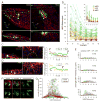Specified neural progenitors sort to form sharp domains after noisy Shh signaling
- PMID: 23622240
- PMCID: PMC3674856
- DOI: 10.1016/j.cell.2013.03.023
Specified neural progenitors sort to form sharp domains after noisy Shh signaling
Abstract
Sharply delineated domains of cell types arise in developing tissues under instruction of inductive signal (morphogen) gradients, which specify distinct cell fates at different signal levels. The translation of a morphogen gradient into discrete spatial domains relies on precise signal responses at stable cell positions. However, cells in developing tissues undergoing morphogenesis and proliferation often experience complex movements, which may affect their morphogen exposure, specification, and positioning. How is a clear pattern achieved with cells moving around? Using in toto imaging of the zebrafish neural tube, we analyzed specification patterns and movement trajectories of neural progenitors. We found that specified progenitors of different fates are spatially mixed following heterogeneous Sonic Hedgehog signaling responses. Cell sorting then rearranges them into sharply bordered domains. Ectopically induced motor neuron progenitors also robustly sort to correct locations. Our results reveal that cell sorting acts to correct imprecision of spatial patterning by noisy inductive signals.
Copyright © 2013 Elsevier Inc. All rights reserved.
Figures







Comment in
-
Sorting sloppy Sonic.Cell. 2013 Apr 25;153(3):509-10. doi: 10.1016/j.cell.2013.04.021. Cell. 2013. PMID: 23622235 Free PMC article.
Similar articles
-
Hedgehog signaling is required for differentiation of endocardial progenitors in zebrafish.Dev Biol. 2012 Jan 15;361(2):377-91. doi: 10.1016/j.ydbio.2011.11.004. Epub 2011 Nov 12. Dev Biol. 2012. PMID: 22119054
-
Distinct Sonic Hedgehog signaling dynamics specify floor plate and ventral neuronal progenitors in the vertebrate neural tube.Genes Dev. 2010 Jun 1;24(11):1186-200. doi: 10.1101/gad.559910. Genes Dev. 2010. PMID: 20516201 Free PMC article.
-
Intracellular Calcium Mobilization Is Required for Sonic Hedgehog Signaling.Dev Cell. 2018 May 21;45(4):512-525.e5. doi: 10.1016/j.devcel.2018.04.013. Epub 2018 May 10. Dev Cell. 2018. PMID: 29754802 Free PMC article.
-
Sonic hedgehog signaling coordinates the proliferation and differentiation of neural stem/progenitor cells by regulating cell cycle kinetics during development of the neocortex.Congenit Anom (Kyoto). 2012 Jun;52(2):72-7. doi: 10.1111/j.1741-4520.2012.00368.x. Congenit Anom (Kyoto). 2012. PMID: 22639991 Review.
-
Control of muscle fibre-type diversity during embryonic development: the zebrafish paradigm.Mech Dev. 2013 Sep-Oct;130(9-10):447-57. doi: 10.1016/j.mod.2013.06.001. Epub 2013 Jun 28. Mech Dev. 2013. PMID: 23811405 Review.
Cited by
-
A strategy for tissue self-organization that is robust to cellular heterogeneity and plasticity.Proc Natl Acad Sci U S A. 2015 Feb 17;112(7):2287-92. doi: 10.1073/pnas.1410776112. Epub 2015 Jan 29. Proc Natl Acad Sci U S A. 2015. PMID: 25633040 Free PMC article.
-
Fast, accurate reconstruction of cell lineages from large-scale fluorescence microscopy data.Nat Methods. 2014 Sep;11(9):951-8. doi: 10.1038/nmeth.3036. Epub 2014 Jul 20. Nat Methods. 2014. PMID: 25042785
-
PCP Signaling between Migrating Neurons and their Planar-Polarized Neuroepithelial Environment Controls Filopodial Dynamics and Directional Migration.PLoS Genet. 2016 Mar 18;12(3):e1005934. doi: 10.1371/journal.pgen.1005934. eCollection 2016 Mar. PLoS Genet. 2016. PMID: 26990447 Free PMC article.
-
Recovery of shape and size in a developing organ pair.Dev Dyn. 2017 Jun;246(6):451-465. doi: 10.1002/dvdy.24498. Epub 2017 Apr 3. Dev Dyn. 2017. PMID: 28295855 Free PMC article.
-
Ventral neural patterning in the absence of a Shh activity gradient from the floorplate.Dev Dyn. 2018 Jan;247(1):170-184. doi: 10.1002/dvdy.24590. Epub 2017 Oct 17. Dev Dyn. 2018. PMID: 28891097 Free PMC article.
References
-
- Ahn S, Joyner AL. Dynamic changes in the response of cells to positive hedgehog signaling during mouse limb patterning. Cell. 2004;118:505–516. - PubMed
-
- Catala M, Teillet MA, De Robertis EM, Le Douarin ML. A spinal cord fate map in the avian embryo: while regressing, Hensen’s node lays down the notochord and floor plate thus joining the spinal cord lateral walls. Development. 1996;122:2599–2610. - PubMed
-
- Chamberlain CE, Jeong J, Guo C, Allen BL, McMahon AP. Notochord-derived Shh concentrates in close association with the apically positioned basal body in neural target cells and forms a dynamic gradient during neural patterning. Development. 2008;135:1097–1106. - PubMed
Publication types
MeSH terms
Substances
Grants and funding
LinkOut - more resources
Full Text Sources
Other Literature Sources
Molecular Biology Databases
Research Materials

